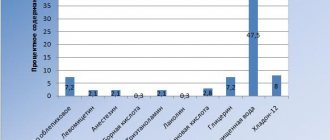Kagocel is an antiviral drug that is effective against colds (ARVI, influenza, parainfluenza, rotavirus, herpes infection and others). The drug has antiviral, immunostimulating and radioprotective effects.
The active ingredient of the drug has a similar name: Kagocel. 1 tablet contains Kagocel 12 mg. Kagocel is a substance of the polyphenol group, obtained by synthesis from water-soluble carmoxymethylcellulose and cotton seed polyphenol.
The therapeutic effect of the pharmacological agent is provided by the active component, based on the ability of Kagocel to stimulate the formation of different types of interferon - the body's natural protective proteins, since specific protein structures activate enzymatic systems to suppress harmful microflora and viral colonies.
Kagocel photo
Since the production of interferon is one of the first immune responses to viral infection, stimulators of the production of this protein occupy a special place among antiviral drugs.
The drug helps increase the production of interferon in various cells involved in the formation of the immune response, including macrophages, granulocytes, T- and B-lymphocytes, endothelial cells and fibroblasts.
When using the drug in children and adult patients, regardless of the characteristics of the course of ARVI, the duration of its symptoms is reduced. It is also noted that the drug increases interferon levels in children and adults with initially insufficient levels.
Indications for use Kagocel
Thus, the indications for use of Kagocel imply its use in adults to prevent infection and treat pathologies of a viral nature. Most often, the medication is used for influenza infections and other respiratory pathologies of viral origin.
Indications for the use of Kagocel are:
- herpes therapy in adult patients;
- treatment and prevention of influenza and other acute respiratory viral infections in children (in particular, over the age of 3 years) and adults;
- decreased immunity;
- bacterial lesions (in complex therapy).
Kagocel can be prescribed together with antibiotics, antipyretics and antihistamines without fear of harm to health. But it is still better to do this no later than 3-4 days after the onset of severe symptoms of a cold.
Instructions for use Kagocel, dosage
Kagocel is intended for oral administration.
For the treatment of influenza and ARVI, adults are prescribed 2 tablets in the first 2 days. 3 times a day, in the next 2 days - 1 tablet. 3 times/day. A total of 18 tablets per course lasting 4 days.
If you need to cope with the herpes virus in the acute phase, you will have to take 30 Kagocel tablets in five days. Usually, such powerful immune support is enough to get rid of unpleasant rashes.
Kagocel for children
Children 3-6 years old with flu, colds and other acute respiratory infections take 1 tablet of Kagocel 2 times a day for two days, then 1 tablet. per day. The duration of the course is 4 days.
For the treatment of influenza and other respiratory viral infections in children over 6 years of age, 1 tablet of Kagocel 3 times a day is prescribed in the first 2 days, and 1 tablet 2 times a day in the next 2 days.
The total duration of treatment is 4 days.
Features of application
The drug does not affect the reaction rate when driving vehicles or working with complex mechanisms.
Kagocel tablets have maximum effectiveness against the proliferation of viruses if used no later than the fourth day after the onset of symptoms.
During treatment, it is undesirable to consume alcohol in any form.
Kagocel tablets composition
Active substance: Kagocel - 12 mg.
Excipients: potato starch 10 mg, calcium stearate - 0.65 mg, Ludipress (directly compressed lactose, Ludipress composition: lactose monohydrate, povidone (Kollidon 30), crospovidone (Koldidon CL)) - to obtain a tablet weighing 100 mg.
Description
The tablets are cream to brown, round, biconvex with inclusions.
Pharmacotherapeutic group: Antiviral agent.
ATX code: [J05AX]
Pharmacological properties:
Pharmacodynamics
The main mechanism of action of Kagocel is the ability to induce interferon production. Kagocel® causes the formation in the human body of the so-called late interferon, which is a mixture of a- and P-interferons with high antiviral activity. Kagocel® causes interferon production in almost all cell populations involved in the body's antiviral response: T- and B-lymphocytes, macrophages, granulocytes, fibroblasts, endothelial cells. When one dose of Kagocel® is taken orally, the interferon titer in the blood serum reaches its maximum values after 48 hours. The body's interferon response to Kagocel® administration is characterized by prolonged (up to 4-5 days) circulation of interferon in the bloodstream. The dynamics of interferon accumulation in the intestine when Kagocel is taken orally does not coincide with the dynamics of circulating interferon titers. In serum 1fovi, interferon production reaches high values only 48 hours after taking Kagocel, while in the intestine the maximum interferon production is observed after 4 hours.
Kagocel®, when prescribed in therapeutic doses, is non-toxic and does not accumulate in the body. The drug does not have mutagenic or teratogenic properties, is not carcinogenic and does not have embryotoxic effects.
The greatest effectiveness in treatment with Kagocel is achieved when it is prescribed no later than the 4th day from the onset of acute infection. For preventive purposes, the drug can be used at any time, including immediately after contact with the infectious agent.
Pharmacokinetics
24 hours after introduction into the body, Kagocel accumulates mainly in the liver, and to a lesser extent in the lungs, thymus, spleen, kidneys, and lymph nodes. Low concentrations are observed in adipose tissue, heart, muscles, testes, brain, blood plasma. The low content of Kagocel® in the brain is explained by the high molecular weight of the drug, which makes it difficult to penetrate the blood-brain barrier. In the blood plasma the drug is found predominantly in bound form.
With daily repeated administration of Kagocel®, the volume of distribution varies widely in all organs studied. The accumulation of the drug is especially pronounced in the spleen and lymph nodes. When taken orally, about 20% of the administered dose of the drug enters the general bloodstream. The absorbed drug circulates in the blood, 1 mainly, in the form associated with macromolecules: with lipids - 47%, with proteins - 37%, The unbound part of the drug is about 16%.
Excretion: the drug is excreted from the body mainly through the intestines: 7 days after administration, 88% of the administered dose is excreted from the body, including 90% through the intestines and 10% at night. The drug was not detected in exhaled air.
Side effects and contraindications Kagocel
In general, Kagocel is well tolerated, provided that the dosage and recommendations for frequency of use are followed. In some cases, intolerance to the active substance Kagocel and the auxiliary components of the drug may occur.
The official annotation for the medication emphasizes that if any symptoms of intolerance appear, you should consult a doctor.
Overdose
If Kagocel is used incorrectly and overdose, there is a risk of developing allergies, headaches, abdominal cramps and gas formation.
Contraindications
One of the contraindications to the use of Kagocel is considered to be a person’s hypersensitivity to the main active ingredient or auxiliary components. At the same time, according to statistical data, few cases of individual intolerance to Kagocel have been registered.
Also, the medication is not used in the following situations:
- Pregnancy and lactation;
- Age up to 3 years;
- Lactase deficiency, lactose intolerance, glucose-galactose malabsorption.
Kagocel side effects
Allergic reactions may develop.
If any of the side effects indicated in the instructions get worse, or you notice any other side effects not listed in the instructions, tell your doctor. Possibility and features of use by pregnant women and women during breastfeeding
Due to the lack of necessary clinical data, Kagocel is not recommended for use during pregnancy and lactation.
Impact on the ability to drive vehicles and machinery
The effect of the drug on the ability to drive vehicles and operate machinery has not been studied.
Overdose
In case of accidental overdose, it is recommended to prescribe plenty of fluids and induce vomiting.
Interaction with other drugs
Kagocel combines well with other antiviral drugs, immunomodulators and antibiotics (additive effect).
special instructions
To achieve a therapeutic effect, Kagocel should be started no later than the fourth day from the onset of the disease.
Photo of packaging of Kagocel tablets with price indication
Release form
Tablets 12 mg.
10 tablets per blister pack made of polyvinyl chloride film and aluminum foil with a heat-sealable coating.
1 contour package along with instructions for use is placed in a pack.
Photo of the packaging of Kagocel tablets indicating the release form
Best before date
2 years. After the expiration date indicated on the packaging, the drug should not be used.
Photo of the packaging of Kagocel tablets with expiration date
Storage conditions
In a dry place, protected from light, at a temperature not exceeding 25 ° C.
Keep out of the reach of children.
Photo of packaging of Kagocel tablets 10 pieces
Conditions for dispensing from pharmacies
Without a doctor's prescription.
Photo of Kagocel 12 mg tablets
Legal entity in whose name the registration certificate was issued
NEARMEDIC PLUS LLC, Russia, 125252, Moscow, st. Aircraft designer Mikoyan, 12, phone/fax: +7 (495) 741-49-89.
Direct consumers to:
NEARMEDIC PLUS LLC, Russia, 125252, Moscow, st. Aircraft designer Mikoyan, 12, phone/fax, e-mail
Manufacturing company
, Russia, 125252, Moscow, st. Aircraft designer Mikoyan, 12, phone/fax: +7 (495) 741-49-89.
Address of place of production: Russia, 123098, Moscow, st. Gamaleyi, 18, building 4,10, I,
18,33.
, Russia, 249030, Kaluga region, Obninsk, Kyiv highway, 62, phone: +7 (48439) 90-500; fax: +7 (48439) 90-525.
Analogues of Kagocel, list of drugs
Analogues of the drug Kagocel are (list):
- Altabor;
- Amizon;
- Amizonchik;
- Arbidol;
- Armenicum;
- Arpeflu;
- Oscillococcinum;
- Groprinosin;
- Isoprinosine;
- Imusstat;
- Novirin;
- Panavir;
- Flavoside;
- Örebra;
- Cycloferon;
- Lycopid;
- Anaferon and others.
Important - instructions for use of Kagocel, price and reviews do not apply to analogues and cannot be used as a guide to the use of drugs of similar composition or action. All therapeutic prescriptions must be made by a doctor. When replacing Kagocel with an analogue, it is important to consult a specialist; you may need to change the course of therapy, dosages, etc. Do not self-medicate!
Effect of the drug on viral infections
How does Kagocel act on the virus? It should be noted that all drugs of the interferon group, to which Kagocel belongs, have an inhibitory effect on viruses. The only question is whether we started treatment immediately or when the virus has progressed throughout the body. In order to understand this, you need to understand that Kagocel is also used prophylactically, why use it prophylactically, and then that Kagocel, penetrating the protein shell of the virus, destroys it and kills the virus from the inside. To do this, in the first days of the disease, the drug may be used in increased doses. Since it has been scientifically established that Kagocel is not toxic, even a reasonable increase in dosage will not harm the body, but it is still best to follow the dosage prescribed by your doctor.
Kagocel for children: instructions for use state that the drug is prescribed to children from 6 years of age, which means that the drug is prohibited from being taken under 6 years of age. Very often, domestic pediatricians ignore age restrictions on drugs, citing the fact that the effect of Kagocel on a child’s body under 6 years of age may not have been studied, which is why the instructions indicate what to take from 6 years of age. But if the drug gives positive results, parents can afford it and children like it, why not give it before 6 years of age? Here everyone decides for themselves.
Kagocel tablets: instructions for use, it is indicated that for adults with an already established disease, a two-day regimen of six tablets per day in three doses is best suited, and from the third day to the fourth inclusive according to the regimen of three tablets in three doses. In preventive practice, Kagocel is recommended to be taken as a weekly course, alternating two days, two tablets each, then a five-day break.
Let's once again recall the drug Kagocel, its use for colds and viral diseases, and another specificity of the drug for herpetic infections in adults. The instructions for use of the drug Kagocel do not separate the course and dosage of taking the drug for colds and herpes, so it would be logical to follow the standard regimen for adults.
Indications for use
Let us clarify the indications for use of Kagocel in order to avoid misunderstandings. The first and most important use of Kagocel is for viral respiratory diseases in children and adults. Another area of application for the drug is urogynecological infections in adults, which ones the doctor will recommend. Also, herpes infection occurs in adults, but it can also occur in children. What then? In the case of Kagocel, it has been established that the drug is non-toxic, but according to the doctor’s decision, this drug can also be used in children.
Kagocel for children:
Kagocel children's instructions for use state that children from six years of age take an increased dosage in the first two days, namely three tablets per day in three doses, and in the next two days two tablets per day, divided into two doses. But what if the child has a body weight almost like that of an adult? It is logical that in this case the child dosage may not be enough for him and then the effectiveness of the drug will be low. Therefore, you should not self-medicate; your doctor will select the dosage individually for you and your children.
The medicine Kagocel is being used in more and more families, because alternative drugs are less effective and more toxic. Let's return once again to the question of Kagocel, method of application and dose. Doses are individual; it is used orally with plenty of fluids, like many analogues. Of course, not all children over 6 years old, and yet the drug is prescribed precisely from this age, are able to swallow a whole tablet. Here the issue is resolved more simply, the main thing is that the child takes the required dose of the drug per day, and even if you break up the tablet and give a couple more doses, the main thing is that you do not exceed the dosage norm.









